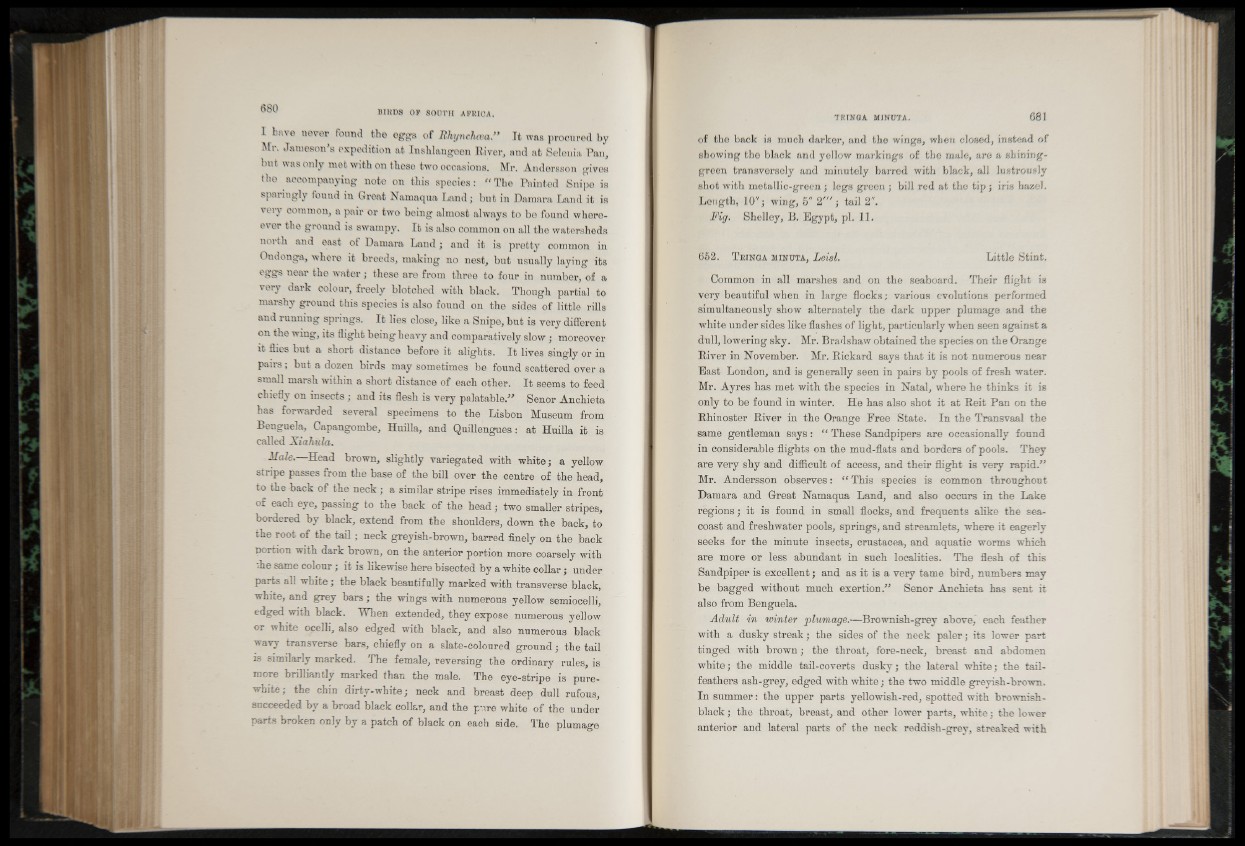
I have never found the eggs of Rhynelma." It was prooured by
Mr. Jameson’s expedition at Inshlangoen River, and at Selenia Pan,
but was only met with on those two ocoasions, Mr. Andersson gives
tho accompanying note on this speoies: "The Painted Snipe is
sparingly found in Great Namaqua Land ; but in Damara Land it is
very common, a pair or two being almost always to be found whenever
the ground is swampy. It is also common on all the watersheds
north and east of Damara Land ; and it is pretty common in
Oudonga, where it breeds, making no nest, but usually laying its
eggs near the water; these are from three to four in number, of a
very dark colour, freely blotched with black. Though partial to
marshy ground this species is also found on the sides of little rills
and running springs. I t lies close, like a Snipe, but is very different
on the wing, its flight being heavy and comparatively slow; moreover
it flies but a short distance before it alights. It lives singly or in
pairs; but a dozen birds may sometimes be found scattered over a
small marsh within a short distance of each other. I t seems to feed
chiefly on insects; and its flesh is very palatable.” Senor Anchieta
has forwarded several specimens to the Lisbon Museum from
Benguela, Capangombe, Huilla, and Quillengues: at Huilla it is
called Xiahicla.
Male. Head brown, slightly variegated with white; a yellow
stripe passes from the base of the bill over the centre of the head,
to the back of the neck ; a similar stripe rises immediately in front
of each eye, passing to the back of the head; two smaller stripes,
bordered by black, extend from the shoulders, down the back, to
the root of the tail ; neck greyish-brown, barred finely on the back
portion with dark brown, on the anterior portion more coarsely with
'he same colour; it is likewise here bisected by a white collar; under
parts all white; the black beautifully marked with transverse black,
white, and grey bars; the wings with numerous yellow semiocelli,
edged with black. When extended, they expose numerous yellow
or white ocelli, also edged with black, and also numerous black
wavy transverse bars, chiefly on a slate-coloured ground; the tail
is similarly marked. The female, reversing the ordinary rules, is
more brilliantly marked than the male. The eye-stripe is pure-
white; the chin dirty-white; neck and breast deep dull rufous,
succeeded by a broad black collar, and the pure white of the under
parts broken only by a patch of black on each side. The plumage
of the back is much darker, and tho wings, when closed, instead of
showing tho black and yellow markings of the male, are a shining-
green transversely and minutely barred with black, all lustrously
shot with metallic-green; legs green ; bill red at the tip ; iris hazel.
Length, 10''; wing, 5" 2///; tail 2".
Fig. Shelley, B. Egypt, pi, 11.
652. T r in g a minuta, Leisl. Little Stint.
Common in all marshes and on the seaboard. Their flight is
very beautiful when in large flocks; various evolutions performed
simultaneously show alternately the dark upper plumage and the
white under sides like flashes of light, particularly when seen against a
dull, lowering sky. Mr. Bradshaw obtained the species on the Orange
River in November. Mr. Rickard says that it is not numerous near
East London, and is generally seen in pairs by pools of fresh water.
Mr. Ayres has met with the species in Natal, where he thinks it is
only to be found in winter. He has also shot it at Reit Pan on the
Rhinoster River in the Orange Free State. In the Transvaal the
same gentleman says: “ These Sandpipers are occasionally found
in considerable flights on the mud-flats and borders of pools. They
are very shy and difficult of access, and their flight is very rapid.”
Mr. Andersson observes: “ This species is common throughout
Damara and Great Namaqua Land, and also occurs in the Lake
regions; it is found in small flocks, and frequents alike the sea-
coast and freshwater pools, springs, and streamlets, where it eagerly
seeks for the minute insects, Crustacea, and aquatic worms which
are more or less abundant in such localities. The flesh of this
Sandpiper is excellent; and as it is a very tame bird, numbers may
be bagged without much exertion.” Senor Anchieta has sent it
also from Benguela.
Adult in winter plumage.—Brownish-grey above, each feather
with a dusky streak; the sides of the neck paler; its lower part
tinged with brown; the throat, fore-neck, breast and abdomen
white; the middle tail-coverts dusky; the lateral white; the tail-
feathers ash-grey, edged with white; the two middle greyish-brown.
In summer: the upper parts yellowish-red, spotted with brownish-
black ; the throat, breast, and other lower parts, white; the lower
anterior and lateral parts of the neck reddish-grey, streaked with